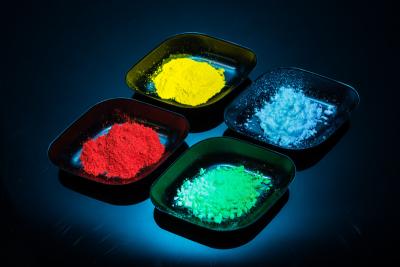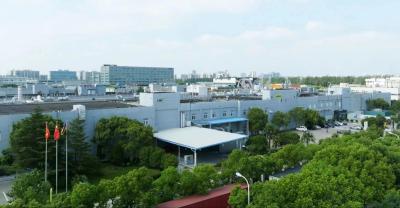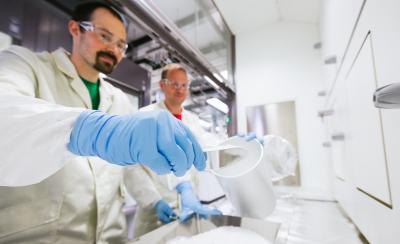Merck KGaA is a pioneer in high performance OLED material development, supplying a range of materials for AMOLED makers since the industry’s inception.
To learn more about Merck’s materials and views on the OLED industry, we conducted an interview with Dr. Georg Bernatz, Merck Electronics’ Global Head of OLED Technical Marketing. Georg Bernatz has received a PhD in Physics from the Philipps-Universität in Marburg, Germany in 2000. In 2004, Georg joined Merck, where, over the years, he worked in various functions and on various topics in the field of Liquid Crystals for displays. In 2018, Georg changed to OLED, leading OLED Physics Product Research, and in 2020 he became responsible for all Physics & Application Labs in Darmstadt for Display materials. Since October 2023, Georg is heading Merck’s Global Technical Marketing for OLED materials.
Hello Dr. Bernatz. Can you bring us up to date quickly on Merck's current OLED material products? What do you offer to OLED display makers?
Merck KGaA, Darmstadt, Germany is very active in the design, development and production of a broad variety of high performing OLED materials, with a strong focus on hole and electron transport materials (HTM, ETM), host materials for phosphorescent emitters as well as activities in the field of high efficiency blue.
Merck has been developing OLED host materials for many years. We understand that you have recently presented advances in material performance, specifically a new green PHOLED host material. Additionally Merck noted a while back that modern host materials need to be more customized and tuneable compared to current host systems. Can you tell us more?
Indeed, our R&D efforts paid off, and we could develop PHOLED host materials with significantly enhanced performance. Still, there is no “one fits all” host, the materials must be wisely chosen with regards to the specific emitter as well as the rest of the stack. Merck’s broad host materials portfolio helps a lot in this context. It has been shown that the host can significantly influence the emitter orientation and thus also the efficiency of the OLED. Moreover, the host influences the capacitance of the OLED device – a property which becomes more and more important with higher display refresh rates. Deuteration of hosts is one important key element to enhance OLED lifetime, having the advantage of not negatively influencing any other physical property and thus Merck is very actively exploring deuteration in the development, scale-up and production of host materials.
But of course, deuteration will not transform a bad material into an “angel” – and thus, the excellent un-deuterated performance of our materials remains key. Finally, Merck offers electron- and hole transporting host materials also as so-called premixes. These are one-bottle combinations with fine-tuned and experimentally proven matched evaporation properties. The extra effort pays off, as they can be evaporated from one crucible, which can significantly ease production equipment complexity, productivity and thus manufacturing cost.
OLED makers are always on the lookout to increase performance. How do you see the stack material development affecting the performance of OLED displays in the future?
The classical triangle of efficiency, voltage and lifetime remains very important, and we are certainly pushing the limits further, also with our advanced transport materials, be it by deuteration or improved and novel molecular structures. Merck has a very broad HTM portfolio and we are constantly building it further. Whilst synthesis, analytics and application testing remain the backbone of our research of next-generation materials, ever-more advanced computer simulations, machine learning and AI are becoming an increasingly important element. These “in silico” experiments allow us to concentrate our “real” experimental efforts on the most promising candidates and thus to effectively shorten development cycles and save resources. It needs to be mentioned that the outcome of our “real” experiments feeds our immense databases and thus in turn provides an improved basis and reality check for our computer simulations and predictions in a constantly evolving cycle.
On the other hand, modern displays are becoming more and more advanced and complex, and thus other effects – or deficiencies – beyond the “triangle” become increasingly relevant. One example is the crosstalk between pixels which affects color purity, or before-mentioned pixel capacitance affecting performance at high driving frequencies. Whilst technical display design and manufacturing techniques of course are key to improving these issues, OLED stack materials can play a big role also! For example, we have demonstrated that innovative HTM materials can significantly contribute to suppressing crosstalk – without affecting stack conductivity. And we have developed HTMs with lower refractive indices, which can lead to improved outcoupling of light und thus higher OLED panel efficiency.
All in all, a more “holistic” view on materials performance is crucial in realizing next generation OLED displays.
In May 2023, Merck sold its OLED emitter IP to UDC, and has entered into a multi-year collaboration agreement, to develop PHOLED stacks. Can you tell us more about this agreement, and how will the collaboration work?
This joint development program brings together Universal Display Corporation’s expertise in leading-edge phosphorescent OLED emitters and Merck’s state-of-the-art transport materials. The objective is to develop higher performing OLED stacks for OLED manufacturers around the world. As a leading OLED material company, having access to UDC’s leading-edge emitters will benefit Merck’s development of transport materials and most importantly boost our capabilities to develop new host materials.
We know that UDC is getting ready to commercialize its blue PHOLED material, which may have a dramatic effect on the efficiency of OLED displays. How do you see the industry's adoption of novel emitters and stack materials going forward?
Of course, we all know that Blue is the pain point for OLED technology, in terms of efficiency and lifetime. Today’s displays are compensating for this using many clever tricks, making OLED panels well competitive in the market. On the other hand, these tricks cause complexity and effort, and thus, technologies and materials which really can make blue OLED stacks more efficient will be a game-changer. But of course, an efficiency-enhancing solution will have to go hand in hand with minimum impact on any other display performance parameter, most prominently lifetime, and smooth mass production processability.
Right now, even though significant progress has been made, it cannot be said that the race is over. And Merck is also part of it with our dedicated materials for the next generation blue emissive layer.
Merck recently inaugurated a new facility in China, and also expanded its facility in Korea. How important is it to be close to your OLED customers? Can you tell us more about these two new production facilities?
Being close to our customers, in the literal sense of proximity, has been key to our long success story in display materials, starting with an LC R&D centre in Japan in the 80’s. Very importantly, this also creates closeness in terms of customer mindset and culture.
Regarding OLED production facilities, this further enhances our footprint in Asia, enabling faster reaction, and even more intimate relationships, also covering an important part of the supply chain. The production facilities include sublimation equipment which guarantee the required ultimate purity as well as improved analysis and quality inspection capabilities of Merck's OLED materials. Shorter distances also have a positive impact on sustainability.
Any more efforts from Merck about sustainability?
Sustainability is close to our heart, and in a huge company like Merck there is simply no way past this important topic: Merck will become carbon neutral by 2040!
More concrete, in OLED we offer recycling and reconditioning of our materials, which were “reclaimed” from our customer’s evaporation tools after completing the display evaporation process. And we start even earlier, at the root, so to say: in R&D. Because whatever we do today in research will define tomorrow’s commercial portfolio. We have developed and introduced across Merck Electronics a Sustainability Scorecard, which is a compulsory element of every gate review in our R&D process. Also, the above-mentioned “in silico” experiments – whilst consuming computer and thus electrical power – significantly reduce energy and CO2 usage, waste and effort in the synthesis and characterization of new OLED materials – because they allow us to concentrate our efforts on the most promising candidates.
Looking further downstream, that is into OLED panel power consumption and lifetime, our materials are an important element in realizing energy-efficient tandem devices, and deuteration boosts device operating life.
In our production processes we strive for a responsible consumption of raw materials, and the high purity and super-reliable quality of Merck OLED materials leads to a robust and sustainable production of panels at our customers.
LCD may be relatively mature as a display technology compared to OLED, and Merck is putting more efforts into next-generation display technologies. Can you let us know how the company views the future of the display industry? What role do you aim to take?
Merck is one of the market and technology leaders in LCs for displays since the beginning of this industry and we keep driving innovation in this fascinating field, as can be seen in novel technologies like UB Cell and IPS Black. They get excited reviews – and they rely on novel materials developed and provided by Merck. We are also looking into other applications of LC materials like dynamic glazing for windows, but LCDs remain top priority for us.
Vision accounts for 80% of human perception and thus, in view of virtually exploding amounts of data being generated, processed and utilized, the prospects for the display market remain very positive. Whilst LCD is the dominant display technology by total area, OLED is strongly growing in high-value market segments, most prominently in smartphone displays and in IT applications. And Merck will keep driving and participating in this growth.
Thank you Dr. Bernatz, for this interesting interview. For more information, and to contact Merck’s OLED team, click here.




